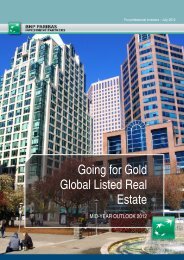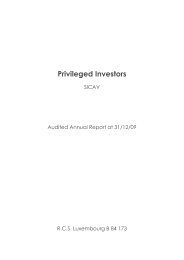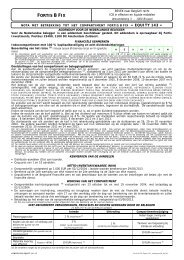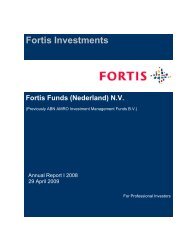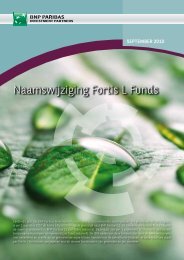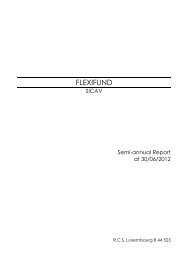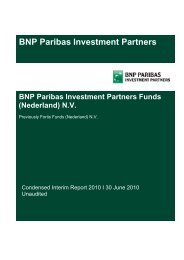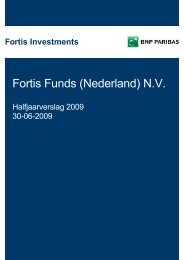Privileged Investors - BNP Paribas Investment Partners
Privileged Investors - BNP Paribas Investment Partners
Privileged Investors - BNP Paribas Investment Partners
You also want an ePaper? Increase the reach of your titles
YUMPU automatically turns print PDFs into web optimized ePapers that Google loves.
<strong>Privileged</strong> <strong>Investors</strong><br />
<strong>Investment</strong> Manager’s Report<br />
Market Review<br />
Although only six months ago, the first half of 2008 seems like a lifetime ago. With so many major events occurring<br />
during the last six months of 2008, perspectives and perceptions over the last year have changed massively. The first six<br />
months saw many interesting developments that were leading indicators on what was to come. We saw continued<br />
volatility in equity and credit indices around the world, from spikes first witnessed in the second half of 2007. The<br />
Federal Reserve Open Market Committee started the year by cutting U.S. interest rates aggressively in an attempt to<br />
pump liquidity back into the system. However, this wasn’t enough to dampen fears of recession, and volatility remained<br />
dominant. The discovery of a rogue trader at Société Générale and the huge potential losses this could mean for the<br />
bank was the first major incident followed very closely by the collapse of Bear Stearns and JP Morgan’s subsequent<br />
Fed-induced purchase. As a result financial stocks were hit hard. Credit spreads displayed high levels of volatility,<br />
widening rapidly through March, contracting in April and May, and jumping back out again in June. Weak economic<br />
data from the U.S. and Europe in June meant that any rally in equities was relatively short-lived and lead to heightened<br />
volatility again. Currency markets displayed less volatility, the yen fell against the dollar initially, but then appreciated<br />
on speculation of the potential need to raise rates later in the year. The pound remained unchanged against the dollar as<br />
the euro gained significantly after the Fed’s aggressive rate-cutting. There was plenty of speculation in commodity<br />
markets and gold continued its strong run on the back of concerns with the global economy and the dollar’s weakness.<br />
Oil and natural gas also continued to rise sharply over fears of lack of supply.<br />
The second half of 2008 seemed to be a turning point. Looking back, there were many warning signs of the problems<br />
which lay ahead and the subsequent large scale deleveraging which was to follow. The foundations for this<br />
deleveraging were laid in 2007 when we first encountered the sub-prime debacle in the U.S.. July saw growing concerns<br />
over the state of U.S. mortgage lenders Fannie Mae and Freddie Mac, and it was also the turning point for commodity<br />
prices. Oil had nearly hit $150 a barrel but with signs of an impending global recession the upward trend of the previous<br />
18 months started to reverse. By the end of the year the price of a barrel of oil had fallen over $100 to around the $40<br />
mark. The collapse of Bear Stearns earlier in the year and growing fear that banks’ exposures to sub-prime would lead<br />
to large write-downs, led to the financial sector being heavily punished. This culminated in the collapse of Lehman<br />
Brothers. The absence of a government rescue package meant the fallout from this was on a scale that most had never<br />
witnessed. Suddenly many financial institutions were on the brink of collapse as widespread panic selling set in. As a<br />
result regulators around the world introduced new rules regarding a ban on the short selling of certain types of stocks,<br />
namely financials. Hedge funds were blamed for this phenomenon but as events unfolded and many banks continued to<br />
suffer after the imposition of these new regulations, it became clear the hedge fund industry was being used as a<br />
scapegoat. This turmoil has subsequently led to high levels of consolidation, Fortis has not been immune to this and at<br />
the time of writing the <strong>BNP</strong> <strong>Paribas</strong> deal is still pending. The latter part of the year saw continued deleveraging in the<br />
financial system, and although equity markets stabilised towards the very end of the year, credit markets continued to<br />
suffer as credit spreads widened to historic levels. Concerns, which were initially limited to the equity and credit<br />
markets started to spread to the broader economy as a series of data releases painted a decidedly negative picture. The<br />
hope was the emerging world would decouple from the developed world and help provide some level of support<br />
through a period of recession. As things stand it looks as if the emerging world is also falling into recession which could<br />
mean the impact is felt for longer and is more severe for those countries involved. One of the by-products of this has<br />
been central banks’ moves to counter the effect of slowing economies by aggressively cutting interest rates. The Federal<br />
Reserve cut rates from over 4% to between 0% and 0.25% at the end of December, similar moves were made by the<br />
Bank of England, where the interest rate stands at 2%, and the European Central Bank which is at 2.5%. All this has<br />
resulted in large moves in the currency markets with the U.S. dollar strengthening, especially against the pound which<br />
ended the year at $1.46 having started the year at around $1.98.<br />
Cadogan Market Neutral Fund<br />
Portfolio Review<br />
Performance at the beginning of 2008 was an indication of what was in store later on in the year. Continuing volatility<br />
in the global market place was reflected in the performance of the fund through the first quarter. Returns were mostly<br />
negative but there was a fairly high level of dispersion from month to month. The Bear Sterns debacle in March had<br />
knock-on effects on performance as investors were forced to deleverage as liquidity dried up. One fixed income fund<br />
lost 35% of its value through March as a result of unprecedented moves in the Japanese fixed income markets. Credit<br />
funds underperformed over the quarter as credit markets continued to experience difficulties. The one beacon of light<br />
was the global macro strategy which was able to identify macro trends in the uncertain environment. Although the<br />
Page 5



